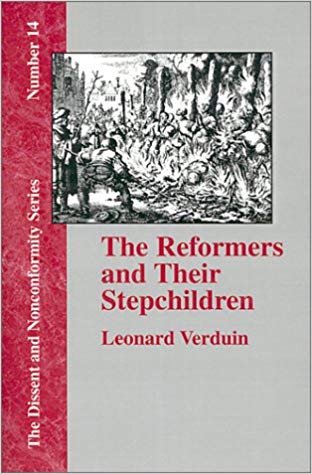A Brief Book Summary from Books At a Glance
By Steve West
About the Author
Leonard Verduin authored several books and translated the works of Menno Simons. For over twenty years he pastored the Campus Chapel at the University of Michigan.
Introduction
In this book, Verduin examines the reasons for the persecution that the Anabaptists experienced at the hands of the Reformers. He argues that the Reformers wanted to establish a sacral society which eliminated all dissent. Since they tried to illegitimately hold together state and church, they relied on civil power to control religious belief and practice. Verduin builds his chapters on the meaning of the derisive epithets that the Reformers used of the dissenters. He maintains that the Anabaptists were actually more biblical in their view of the relationship between church and state, with the concomitant belief in religious freedom.
Table of Contents
Chapter One: Donatisten!
Chapter Two: Stäbler!
Chapter Three: Catharer!
Chapter Four: Sacramentschwärmer!
Chapter Five: Winckler!
Chapter Six: Wiedertäufer!
Chapter Seven: Kommunisten!
Chapter Eight: Rottengeister!
Postscript
Book Summary
Chapter One: Donatisten!
The Reformers fought against Rome as their first front, but also fought against those who rejected allying with the state to enforce Christian sacralism as their second front. They heaped terms of opprobrium upon those who belonged to the second front (which were their stepchildren). One classic title was “Donatist.” The NT gave a vision where the church and state were separate, and where the church operated with moral suasion, not the sword. The OT was a sacral society, but the NT has a different vision—if the Reformers had realized that, things could have been much different. State and church operate in different spheres and demand different loyalties. Society is to be composite, not monolithic. Rome was a pagan sacral society, and unfortunately over time Christians made the mistake of wanting to set up a Christian sacral society in its place, where the realm was to be Christianized rather than Christians being those who belonged to the fellowship of believers. Constantine erred greatly by thinking the cross was a sign in which to have political conquest.
It was against this hybrid system that Donatism objected. They were not surprised when troops were sent to oppose their message that the state could not enforce religious beliefs. They rejected the Christian sacralism of Constantinianism, believing the church was for believers, not for a general national population. From the fourth century until the Reformation, there were groups that espoused the Donatist position. The Reformers, however, wanted a new sacral society; this is why they called the second front the “Donatists” or “Neo-Donatists.” The stepchildren didn’t want the Reformers to join their church to the power of the state. They had to oppose over a millennium of sacral society thinking—if it wasn’t for the NT, their project would have been impossible. Constantine had done something unprecedented: he had put the sword into the service of the church’s faith, and the church continued to desire its use. The church moved the arm that held the sword. The stepchildren believed that there should be a magistrate with lawful authority, but that they ought not to use the sword to enforce Christian doctrine. For the Reformers, heresy must be punished with the sword. It was this thinking that led Calvin to execute Servetus (Calvin was in fact mainly responsible for it). The burning of Servetus did produce an outcry, but Calvin defended himself and the entire concept of a sacral society where heretics should be executed. Calvin, like the other Reformed leaders, fully endorsed the Constantinian development.
Chapter Two: Stäbler!
Constantianism replaced voluntary belief in Christian doctrine with coercion. Rather than wielding a sword, the stepchildren wielded a shepherd’s staff, for which they were labelled “stäbler.” The Donatists wanted to separate from the established church, but they were met with coercion. Augustine believed the Donatists should be compelled into the church. In medieval Europe, baptism by force was common. The state church of the medieval period was not a company of voluntary believers, but rather a people held together by secular force. It was understood that the state could not coerce belief, but it could coerce attendance and limit freedom of speech. The Reformers’ stepchildren denied that coercion was a tool of the church. Calvin, like Luther, struggled between seeing the church as a company of believers, and accepting the medieval model of. . .
[To continue reading this summary, please see below....]The remainder of this article is premium content. Become a member to continue reading.
Already have an account? Sign In
Buy the books

The Reformers and Their Stepchildren